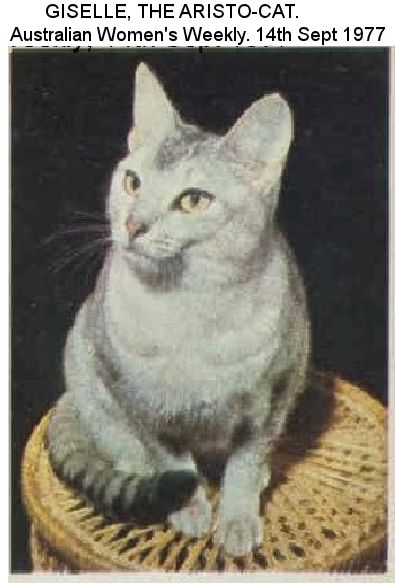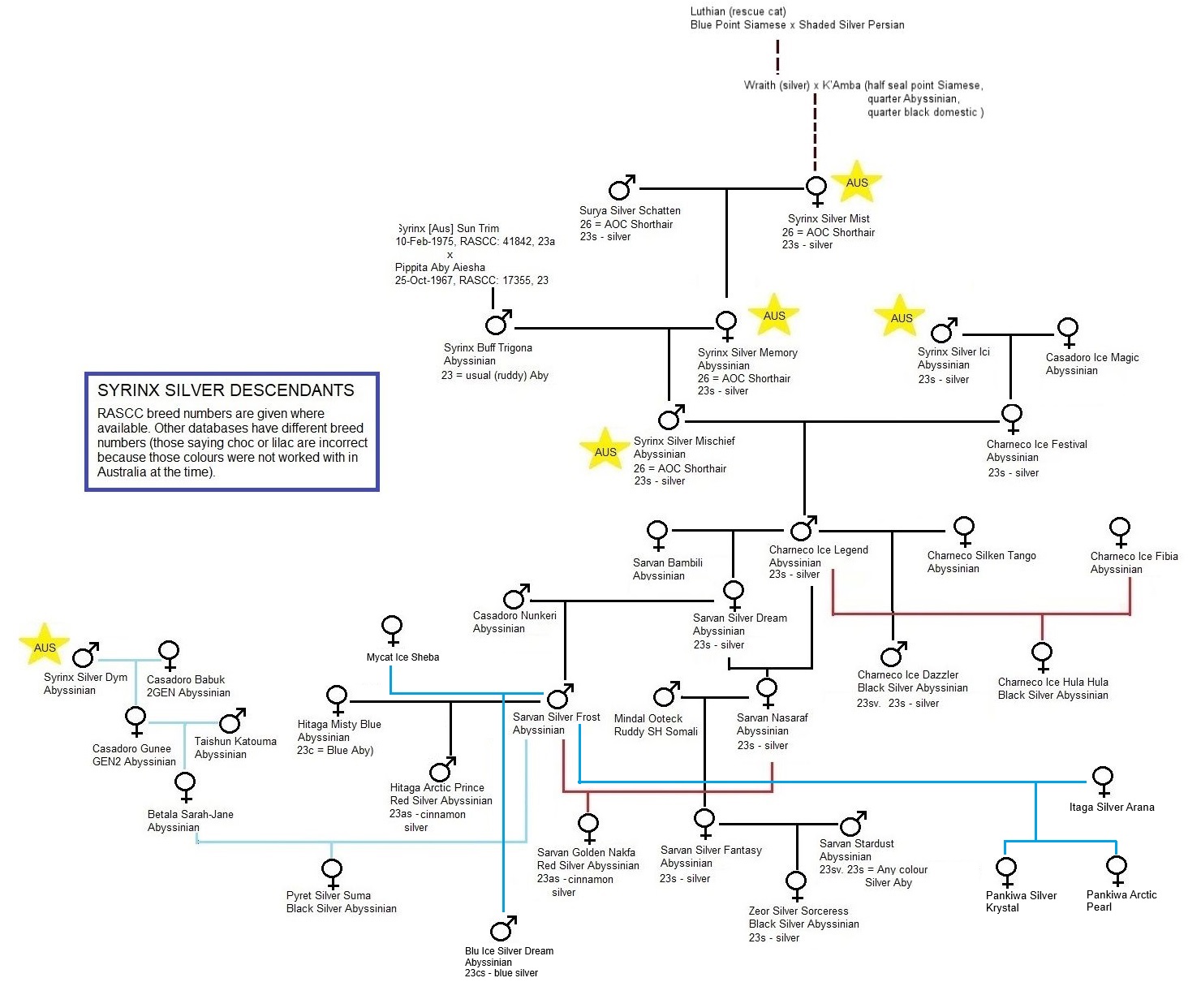
LOST BREEDS - SYDNEY SILVER (AUSTRALIA) - A FORGOTTEN CHAPTER IN SILVER ABYSSINIANS
The Sydney Silver is an almost forgotten chapter in the development of Silver Abyssinians in Australia. The breed began with an accidental cross of a Blue Point Siamese and Shaded Silver Persian. Rescued from destruction, the unwanted kitten, named Luthian, was adopted by an Abyssinian breeder who saw potential in the attractive cat. Mated to an Abyssinian, some of the kittens were attractive silvers, but others reverted to the Abyssinian colour. An American geneticist recommended introducing either a sealpoint (genetically black) Siamese or the palest possible dilute colour of Siamese (lilac point). A half seal point Siamese, quarter Abyssinian and quarter black domestic shorthair called K Amba was mated to one of the silvers, Wraith. The developing breed was provisionally named Silver Ticked Foreign Shorthairs, then became Sydney Silver (reflecting its Australian origins) and eventually became Silver Abyssinians.

HOW TO BREED KITTENS WITH A COAT OF SILVER. The Sydney Morning Herald, 12th August 1976.
'A new breed of silver short-haired cats needs a name. And it has to be a name that conveys their gentle, dream-like quality. Mrs June Scott, who pioneered their development thinks that the silver cats are a world first. Although she has no name for the breed, the kittens are named after the famous Rolls Royce cars - Silver Shadow, Silver Cloud, Silver Phantom, Silver Ghost and Silver Dawn. They will be shown for the first time at the Macquarie Show in the Father O'Reilly Hall, Auburn, on September 18. Permission has been given by the RAS for them to be developed as a new breed.
The forerunner of what Mrs Scott hopes will be a distinguished new line is Luthian, named after Tolkien's fairy princess with the mantle of silver. "She was an accident really - I found her at the vet's. The result of mating a blue point Siamese and a shaded silver Persian, she was going to be destroyed if a home couldn't be found."
Luthian survived to join Mrs Scott, about 18 other cats and numerous kittens in her home at Randwick. The silver cats are quite different from the golden Abyssinians which feature in their ancestry. "The Abyssinian is a sun cat and was worshipped as such by the ancient Egyptians, but the silvers look their best under moonlight," said Mrs Scott. "They have a dream-like quality and I love to watch their antics on a summer night - they seem to flit like little ghosts."
The bodies as well as the colours are different from other breeds from which they originated. The head, for instance, is a modified version of the Siamese flat wedge shape. It has developed a softer look with a slight roundness, but not as rounded as the Burmese. Temperament has also been taken into consideration in the breeding.
"They have a gentle nature, but they are a freedom-loving cat that wouldn't be suited to life in a flat," said Mrs Scott. "They need trees to climb and plenty of space. At the same time they have the happy knack of getting along with humans. For breeding we have kept the extroverted kittens that weren't put off by people. We let go some promising kittens that didn't display the right temperament."
The kittens have been so attractive that there has been no problem finding homes for any discarded from the breeding program. The second step in Mrs Scott's experimental line is Wraith, produced by mating Luthian with a pure-bred Abyssinian. "It's very difficult breeding anything new - Wraith was the only silver kitten in the litter," she said.
Five other Sydney cat breeders had been experimenting to develop a silver breed and other silver kittens had been produced, mainly descendants of Luthian. But there were numerous problems developing the new strain. When. these silver cats were mated their kittens tended to revert to the Abyssinian type with a fawn-beige tint to the fur. Cat breeders experimenting with a silver type in England had the same problem, but the first breakthrough came when Mrs Scott wrote to an American geneticist. "He suggested that we introduce either some pure black hybrid Siamese or alternatively our palest most dilute colour, which is our lilac Siamese, into the strain." This brought K'Amba into the act - he is half seal point Siamese, quarter Abyssinian and quarter black domestic. "He was mated with Wraith, and bingo - the result was an entirely silver litter," said Mrs Scott. "Others have been produced this way and at last we can mate silver to silver without reversion."
The kittens have chartreuse colour eyes that look as though they have been ringed with dark eye-liner. "We hope to develop the eye colour to a brighter green, but green is definitely the colour that goes with their silver coats."
Their miaow is high and bird-like - not unlike the call of a peregrine falcon, according to Mrs Scott. At present the new breed is known as silver ticked foreign shorthairs. "But what we really want is a name that reflects their qualities - and it should be Australian if possible. They were developed in Australia even if they are not indigenous," said Mrs Scott.'

GISELLE, THE ARISTO-CAT. Australian Women's Weekly. 14th Sept 1977
"Look closely at the splendid cat in Ern McQuillan's picture. This is no ordinary moggie. Her like has not been seen for more than 70 years. Syrinx Silver Giselle is an aristocrat among Abyssinian cats. What's more, she is a throwback to the silver Abyssinian breed last recorded in the 1890s. Sydney cat breeder Lois Sabine and her friends Ron Cole, Miriam Cook. Martin Pether and June Scott have been trying to reproduce the breed since 1973. They believe their success is a world first. The Federal Cat Club of Australasia named Giselle as best experimental cat. The Royal Agricultural Society of NSW now has her breed on the books as Silver-Ticked Foreign Shorthair.
"Giselle has barring on her front legs, but we will eliminate that in subsequent litters." Lois told Gillian Chalmers.
Five generations of Silver-Ticked Foreign Shorthairs are needed to establish the breed to the satisfaction of the RAS."
June Scott, Sydney, NSW and Brisbane, Queensland, was a breeder of Abyssinians at Syrinx cattery between 1974 and the late 1980s. The Silver-Ticked Foreign Shorthairs ecame "Sydney Silvers" which then became Silver Abyssinians.
Truda Straede used one of the "Sydney Silver" males in her Australian Mist breeding programme, which might also have introduced caramels into the Mist. A male called Syrinx Silver Mischief, recorded on an Australian Mist database was bred to a female called Charneco Ice Festival resulting in a silver Abyssinian called Charneco Ice Legend (born 1982).

In the 1980s, there were show classes for Sydney Silver/Silver Ticked breed at the Sydney shows.
Royal Easter Show Results - The Sydney Morning Herald, 18th April, 1984:
Colour Section: Shorthair Male Cats. Sydney Silver champion: Mrs S.A. Sandry's Sarvan Silver Knight.
Colour Section: Shorthair Female Kittens. Sydney Silver champion: J and Mrs A.W. Sargent's Sarvan Silver Dream.
Royal Easter Show Results - The Sydney Morning Herald, 13th April, 1987:
Sydney Silver Silver Ticked: J and Mrs A.W. Sargent's Sarvan Silver Fantasy.
Sarvan Silver Dream, who won as a Sydney Silver in 1984, went on to win as an Abyssinian Silver in 1989 and 1990.
Using Ice Mischief as a lead, I have traced some of the Syrinx silver cats downwards. They were registered with GCCF-style codes, which RAS used at that time (the way these codes were used changed, making some databases misleading).
